INSTITUT SUPERIEUR D'ANTHROPOLOGIE
INSTITUTE OF ANTHROPOLOGY
ONLINE COURSES / COURS A DISTANCE
SPRING TERM : APRIL 2015
REGISTER NOW
USA – 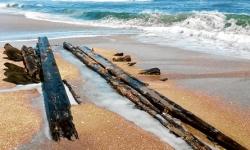 South Core Banks - Having the Graveyard of the Atlantic as your backyard can make for unexpected discoveries. The staff at Cape Lookout National Seashore came across large pieces of timber out on South Core Banks that appear to be from a shipwreck, though very little is known at this time, said park ranger Steve Neshkoff, who work in the park’s interpretive division. He said they initially discovered the apparent wreckage on Dec. 28, including a large section of timber pieces about 40 feet by 60 feet. Upon return to the area on Dec. 31, two more large pieces were found — one of the pieces 37 feet long.,They were all in an area about a mile from the Cape Lookout Lighthouse heading toward the point.
South Core Banks - Having the Graveyard of the Atlantic as your backyard can make for unexpected discoveries. The staff at Cape Lookout National Seashore came across large pieces of timber out on South Core Banks that appear to be from a shipwreck, though very little is known at this time, said park ranger Steve Neshkoff, who work in the park’s interpretive division. He said they initially discovered the apparent wreckage on Dec. 28, including a large section of timber pieces about 40 feet by 60 feet. Upon return to the area on Dec. 31, two more large pieces were found — one of the pieces 37 feet long.,They were all in an area about a mile from the Cape Lookout Lighthouse heading toward the point.
http://www.jdnews.com/news/local/large-beams-found-at-south-core-banks-1.423504
ROYAUME UNI – 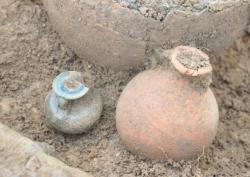 Luton - An archaeological dig at Luton’s Vale Cemetery has uncovered human remains and other material dating back to the early Iron Age through to post Medieval periods. A draft report from Oxford Archaeology East, commissioned by Luton Borough Council, reveals that during excavation work carried out at the end of 2013 in the area of a proposed extension to the cemetery, archaeologists uncovered signs of at least three roundhouses along with enclosures, boundary ditches and various pits. The range of exciting material finds includes seven urned early Roman cremations, three brooches, a bath flask, a significant amount of Roman pottery and some Medieval pottery. The earliest evidence for occupation of the area dates back to the Neolithic and Bronze Age. Cllr Aslam Khan, portfolio holder for the cemetery and crematorium, said: “It is extraordinary to think the Vale Cemetery has been a special place for both the living and the dead for so very long. We already know our town has been an important settlement for thousands of years, but exciting discoveries like this help us to understand and learn more about how ancient people lived and died.” Cllr Khan added: “Significant archaeological finds are expected to be presented to Luton Museum in due course. But we are hoping it will eventually be possible reinter the Roman burial urns near to the spot they were discovered, with appropriate respect and a commemorative information plaque.” The cemetery’s extension is expected to open in the summer, with new paths and roads helping to make it easier to move around the site.
Luton - An archaeological dig at Luton’s Vale Cemetery has uncovered human remains and other material dating back to the early Iron Age through to post Medieval periods. A draft report from Oxford Archaeology East, commissioned by Luton Borough Council, reveals that during excavation work carried out at the end of 2013 in the area of a proposed extension to the cemetery, archaeologists uncovered signs of at least three roundhouses along with enclosures, boundary ditches and various pits. The range of exciting material finds includes seven urned early Roman cremations, three brooches, a bath flask, a significant amount of Roman pottery and some Medieval pottery. The earliest evidence for occupation of the area dates back to the Neolithic and Bronze Age. Cllr Aslam Khan, portfolio holder for the cemetery and crematorium, said: “It is extraordinary to think the Vale Cemetery has been a special place for both the living and the dead for so very long. We already know our town has been an important settlement for thousands of years, but exciting discoveries like this help us to understand and learn more about how ancient people lived and died.” Cllr Khan added: “Significant archaeological finds are expected to be presented to Luton Museum in due course. But we are hoping it will eventually be possible reinter the Roman burial urns near to the spot they were discovered, with appropriate respect and a commemorative information plaque.” The cemetery’s extension is expected to open in the summer, with new paths and roads helping to make it easier to move around the site.
http://www.lutontoday.co.uk/news/community/community-news/roman-link-to-local-cemetery-1-6515877
FRANCE – 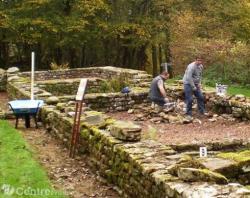 Compierre - Dans le cadre de la préprogrammation 2015-2016 du Service régional de l'archéologie de Bourgogne (Dijon), l'association des Amis de Compierre, présidée par Guy Jardet, a engagé, en septembre dernier, une demande de travaux de restauration sur le forum et l'atelier du tabletier de l'antique cité. En effet, les intempéries des deux dernières années ont provoqué une dislocation et un glissement de la partie bâtie à l'angle sud du forum et une éventration des murs sur toute leur longueur, risquant l'effondrement du mur de l'atelier du tabletier.
Compierre - Dans le cadre de la préprogrammation 2015-2016 du Service régional de l'archéologie de Bourgogne (Dijon), l'association des Amis de Compierre, présidée par Guy Jardet, a engagé, en septembre dernier, une demande de travaux de restauration sur le forum et l'atelier du tabletier de l'antique cité. En effet, les intempéries des deux dernières années ont provoqué une dislocation et un glissement de la partie bâtie à l'angle sud du forum et une éventration des murs sur toute leur longueur, risquant l'effondrement du mur de l'atelier du tabletier.
http://www.lejdc.fr/nievre/actualite/pays/haut-nivernais/2015/01/07/le-site-archeologique-de-compierre-se-refait-une-sante_11282067.html
FRANCE – 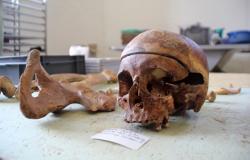 Rennes - Décidément, le chantier de fouilles de la place Saint-Germain fait parler de lui. Après la découverte de vestiges du bombardement de Rennes en 1944 en septembre et d'une bombe anglaise de 150 kilos quelques jours plus tard, les archéologues viennent de mettre au jour des restes humains. «Nous sommes probablement sur un cimetière datant du Moyen Age», expliquent les chercheurs de l'Institut national de recherches archéologiques préventives (Inrap).
Rennes - Décidément, le chantier de fouilles de la place Saint-Germain fait parler de lui. Après la découverte de vestiges du bombardement de Rennes en 1944 en septembre et d'une bombe anglaise de 150 kilos quelques jours plus tard, les archéologues viennent de mettre au jour des restes humains. «Nous sommes probablement sur un cimetière datant du Moyen Age», expliquent les chercheurs de l'Institut national de recherches archéologiques préventives (Inrap).
http://www.20minutes.fr/rennes/1510739-20150106-rennes-squelettes-trouves-place-saint-germain
ROYAUME UNI – 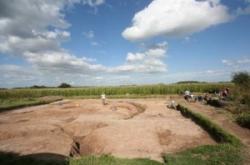 Poulton - Excavation on the ‘lost’ 12th century Poulton Abbey has been underway at Poulton for 20 years. This work has revealed ditches, kilns, thousands of artifacts, and building materials. Geophysical survey suggests a major, high-status Roman presence on the site — possibly a villa or temple complex — but, as yet, no positive identification as to its location. The Poulton Roman Landscape Project seeks to characterize the nature of this Romano-British aspect of the site.
Poulton - Excavation on the ‘lost’ 12th century Poulton Abbey has been underway at Poulton for 20 years. This work has revealed ditches, kilns, thousands of artifacts, and building materials. Geophysical survey suggests a major, high-status Roman presence on the site — possibly a villa or temple complex — but, as yet, no positive identification as to its location. The Poulton Roman Landscape Project seeks to characterize the nature of this Romano-British aspect of the site.
http://www.archaeology.co.uk/digging/fieldwork/poulton-research-project.htm?
AZERBAIDJAN - Head of Numismatics Department of the ANAS Institute of Archeology and Ethnography, Akif Guliyev told APA that the department cleared, determined and developed catalogs of coins found in Aghsu, Shamakhi, Baku, Berde, Ganja, Kurdamir, Jalilabad, Shaki, Gabala, Ismayilli, Shamkir, Imishli and Yardimli districts in recent years. Guliyev noted that main directions of the activity of the numismatics department include the study of coin minting and circulation of money, study of coins discovered during archaeological investigations, training of specialists in the field of numismatics, preparation of "Catalogue of the Azerbaijani coins" for publication and others. Shamakhi-Agsu Archaeological Expedition Head Akif Guliyev said that the expedition conducted archaeological researches in Khinisli settlement and necropolis near Shamakhi, Gulustan Tower, Nargizava, Bijo and Jarmadil Cərmədil necropolises in Aghsu, Gurdtepe medieval settlement, Haji Hatamli and Ismayilli necropolises in ismayilli district. "Muradkhan treasure catalog" compiled by Akif Guliyev won grant project of Science Development Foundation under the President of the Republic of Azerbaijan.
http://en.apa.az/-_221560.html?
PAPOUASIE - Jayapura- The Archaeology Office of Jayapura, Papua, has discovered prehistoric bracelet artifacts made from coral sea shells in Puay Village, East Sentani Sub-District, Jayapura, Papua. "Most of the coral sea bracelets found in the hill slopes have been eroded by the water flowing in Lake Sentani," Hari Suroto, an archaeologist, stated here on Monday. Some of the bracelets were found in good shape, while others were discovered in fragments. The bracelets are made from coral sea shells belonging to the Conidae family. "This kind of coral can be found in the coasts of the Pacific Ocean. The bracelets are white, and their shapes are good and smooth," Hari revealed. He stated that geographically, Puay Village is located at the intersection of Lake Sentanis estuary and Jaifuri Rivers upstream. According to information obtained from the locals, the coral sea bracelets were used as jewelry and dowry during the prehistoric era. "It is interesting that the coral sea bracelets were found in the fresh water area of Lake Sentani," Hari stated, adding that the current facts indicate that the people living near Lake Sentani had been in contact with those residing in the eastern coasts of the Pacific Ocean via the Jaifuri River that empties into the Pacific Ocean. "The bracelets prove the Sentani tribes legends that their ancestors migrated from Vanimo, Papua New Guinea, in the eastern part to Lake Sentani some 2,590 years ago," Hari added.(*)
http://www.antaranews.com/en/news/97308/archaeology-office-unearths-prehistoric-bracelets-in-jayapura-papua